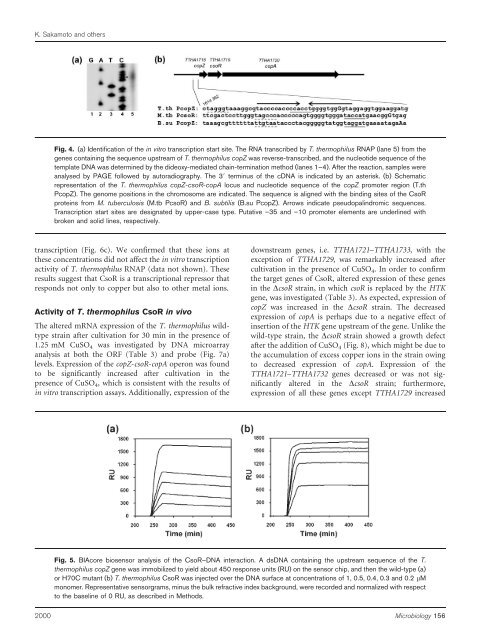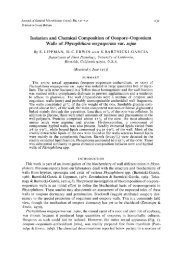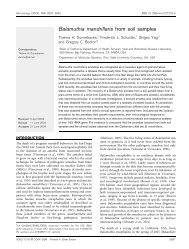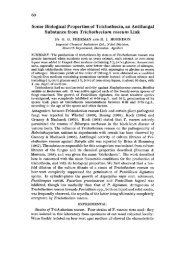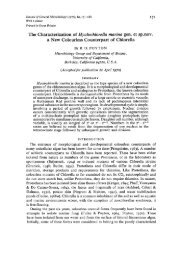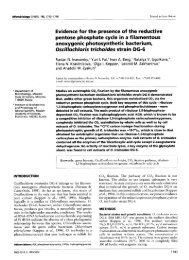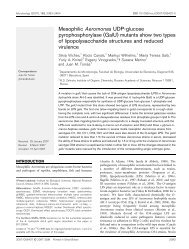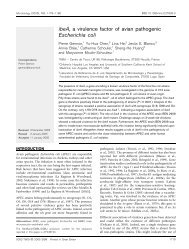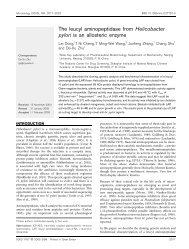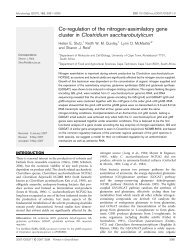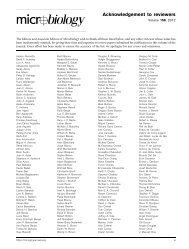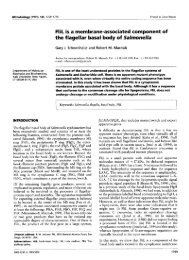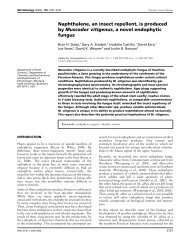Structural and functional characterization of the ... - Microbiology
Structural and functional characterization of the ... - Microbiology
Structural and functional characterization of the ... - Microbiology
You also want an ePaper? Increase the reach of your titles
YUMPU automatically turns print PDFs into web optimized ePapers that Google loves.
K. Sakamoto <strong>and</strong> o<strong>the</strong>rs<br />
Fig. 4. (a) Identification <strong>of</strong> <strong>the</strong> in vitro transcription start site. The RNA transcribed by T. <strong>the</strong>rmophilus RNAP (lane 5) from <strong>the</strong><br />
genes containing <strong>the</strong> sequence upstream <strong>of</strong> T. <strong>the</strong>rmophilus copZ was reverse-transcribed, <strong>and</strong> <strong>the</strong> nucleotide sequence <strong>of</strong> <strong>the</strong><br />
template DNA was determined by <strong>the</strong> dideoxy-mediated chain-termination method (lanes 1–4). After <strong>the</strong> reaction, samples were<br />
analysed by PAGE followed by autoradiography. The 39 terminus <strong>of</strong> <strong>the</strong> cDNA is indicated by an asterisk. (b) Schematic<br />
representation <strong>of</strong> <strong>the</strong> T. <strong>the</strong>rmophilus copZ-csoR-copA locus <strong>and</strong> nucleotide sequence <strong>of</strong> <strong>the</strong> copZ promoter region (T.th<br />
PcopZ). The genome positions in <strong>the</strong> chromosome are indicated. The sequence is aligned with <strong>the</strong> binding sites <strong>of</strong> <strong>the</strong> CsoR<br />
proteins from M. tuberculosis (M.tb PcsoR) <strong>and</strong> B. subtilis (B.su PcopZ). Arrows indicate pseudopalindromic sequences.<br />
Transcription start sites are designated by upper-case type. Putative –35 <strong>and</strong> –10 promoter elements are underlined with<br />
broken <strong>and</strong> solid lines, respectively.<br />
transcription (Fig. 6c). We confirmed that <strong>the</strong>se ions at<br />
<strong>the</strong>se concentrations did not affect <strong>the</strong> in vitro transcription<br />
activity <strong>of</strong> T. <strong>the</strong>rmophilus RNAP (data not shown). These<br />
results suggest that CsoR is a transcriptional repressor that<br />
responds not only to copper but also to o<strong>the</strong>r metal ions.<br />
Activity <strong>of</strong> T. <strong>the</strong>rmophilus CsoR in vivo<br />
The altered mRNA expression <strong>of</strong> <strong>the</strong> T. <strong>the</strong>rmophilus wildtype<br />
strain after cultivation for 30 min in <strong>the</strong> presence <strong>of</strong><br />
1.25 mM CuSO4 was investigated by DNA microarray<br />
analysis at both <strong>the</strong> ORF (Table 3) <strong>and</strong> probe (Fig. 7a)<br />
levels. Expression <strong>of</strong> <strong>the</strong> copZ-csoR-copA operon was found<br />
to be significantly increased after cultivation in <strong>the</strong><br />
presence <strong>of</strong> CuSO4, which is consistent with <strong>the</strong> results <strong>of</strong><br />
in vitro transcription assays. Additionally, expression <strong>of</strong> <strong>the</strong><br />
downstream genes, i.e. TTHA1721–TTHA1733, with <strong>the</strong><br />
exception <strong>of</strong> TTHA1729, was remarkably increased after<br />
cultivation in <strong>the</strong> presence <strong>of</strong> CuSO4. In order to confirm<br />
<strong>the</strong> target genes <strong>of</strong> CsoR, altered expression <strong>of</strong> <strong>the</strong>se genes<br />
in <strong>the</strong> DcsoR strain, in which csoR is replaced by <strong>the</strong> HTK<br />
gene, was investigated (Table 3). As expected, expression <strong>of</strong><br />
copZ was increased in <strong>the</strong> DcsoR strain. The decreased<br />
expression <strong>of</strong> copA is perhaps due to a negative effect <strong>of</strong><br />
insertion <strong>of</strong> <strong>the</strong> HTK gene upstream <strong>of</strong> <strong>the</strong> gene. Unlike <strong>the</strong><br />
wild-type strain, <strong>the</strong> DcsoR strain showed a growth defect<br />
after <strong>the</strong> addition <strong>of</strong> CuSO 4 (Fig. 8), which might be due to<br />
<strong>the</strong> accumulation <strong>of</strong> excess copper ions in <strong>the</strong> strain owing<br />
to decreased expression <strong>of</strong> copA. Expression <strong>of</strong> <strong>the</strong><br />
TTHA1721–TTHA1732 genes decreased or was not significantly<br />
altered in <strong>the</strong> DcsoR strain; fur<strong>the</strong>rmore,<br />
expression <strong>of</strong> all <strong>the</strong>se genes except TTHA1729 increased<br />
Fig. 5. BIAcore biosensor analysis <strong>of</strong> <strong>the</strong> CsoR–DNA interaction. A dsDNA containing <strong>the</strong> upstream sequence <strong>of</strong> <strong>the</strong> T.<br />
<strong>the</strong>rmophilus copZ gene was immobilized to yield about 450 response units (RU) on <strong>the</strong> sensor chip, <strong>and</strong> <strong>the</strong>n <strong>the</strong> wild-type (a)<br />
or H70C mutant (b) T. <strong>the</strong>rmophilus CsoR was injected over <strong>the</strong> DNA surface at concentrations <strong>of</strong> 1, 0.5, 0.4, 0.3 <strong>and</strong> 0.2 mM<br />
monomer. Representative sensorgrams, minus <strong>the</strong> bulk refractive index background, were recorded <strong>and</strong> normalized with respect<br />
to <strong>the</strong> baseline <strong>of</strong> 0 RU, as described in Methods.<br />
2000 <strong>Microbiology</strong> 156


